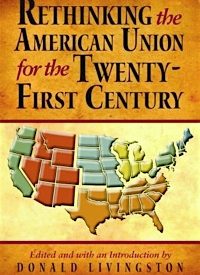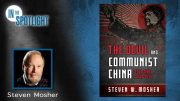
During the fallout following the government bailout of banking, investment, insurance, and the auto industry, President Obama justified the extension of corporate welfare by informing the American people that these businesses were “too big to fail.”
Regardless of the logic of such a stance, in the history of republican political thought, the opposite of the Obama Doctrine has been asserted as axiomatic. As the theory went (goes), a republic cannot function properly toward the end of preserving liberty if it grows too large. One might say of republics that they can be “too big to succeed.”
That is the sentiment behind a recent collection of essays addressing the increasingly untenable size of the federal government and the possibility and desirability of its perpetuation.
Rethinking the American Union for the Twenty-first Century is a collection of seven essays compiled and edited by Donald Livingston. The collection is an extension of the Abbeville Conference held in Charleston, South Carolina in 2010. Contributing scholars include Dr. Thomas DiLorenzo, Yuri Maltsev, Kent Masterson Brown, Marshall DeRosa, Kirkpatrick Sale, and Rob Williams.
An author in his own right, Donald Livingston is a professor of philosophy at Emory University. He has published two books on the influential Scottish philosopher David Hume. He is one of the founders of the Abbeville Institute.
According to its website, the Abbeville Institute is “an association of scholars in higher education devoted to a critical study of what is true and valuable in the Southern tradition.” Its principal activities are a summer school for graduate students and an annual scholars’ conference. The Institute, which focuses chiefly on issues related to secession, is named for the South Carolina hometown of John Calhoun, an advocate of nullification and secession and the primary force behind the Nullification Crisis of the 1830s.
The introduction to this compilation of scholarly essays explains that the move toward globalism requires “some fundamental re-thinking of the political and philosophical assumptions that have led to our current condition.”
The re-thinking contained in this work is not simple regurgitation of the typical solutions offered by pundits and politicians. The introduction plainly declares that in this book readers will nowhere find an admonition to “elect better leaders who will cut spending, cut the size of government, enforce our immigration laws, restore the constitution, and the like.”
Rather, the purpose of this new compilation (available next month from Pelican Publishing Company) is to explore the issue of whether the federal government of the United States of America has grown too large to be an instrument of liberty. Have the states become “little more than administrative units of the central government? Is nearly “every aspect of life…under regulation of the central government”?
In his introduction, the editor informs readers that Congress, the courts, and the regulatory morass of the executive branch have combined to eradicate the sovereignty of the states and to turn Washington, D.C. into nothing more than “a scene of frenzied pork barrel spending, waste, inefficiency, corruption, and special interest patronage for the politically well connected.”
The several authors offer various solutions to these very real, very pressing concerns over the future of our Republic. They range from the radical proposal of secession to the increasingly more popular idea of nullification.
In the opening article, Kent Masterson Brown, an attorney specializing in constitutional law, argues:
[T]he text of the Constitution and the public acts that created it establish that the Constitution ratified by the states in 1789 was understood to be a compact between the states. The common law of contracts going back to Magna Carta allows rescission or annulment of a contract as a remedy in law. Since the states are parties to the constitutional compact, they could employ this right of rescission to secede and re-federate, if they so desired….
This proposition is certainly outside the typical range of solutions offered by the majority of commentators. The notion of cutting, capping, and balancing is nowhere to be found in this bold interpretation of the constitutional history of the United States.
In the second of the assembled offerings, Marshall DeRosa’s “The Tenth Amendment Awakening, The Supreme Court be Damned,” the author observes,
The Tenth Amendment movement, with its resolutions and amendments regarding state sovereignty and the right of states to nullify unauthorized acts of the central government is making a big mistake in seeking a remedy in federal courts.
This same point has been made recently in The New American (e.g., Constitutional Sheriff Bill Introduced in Tenn.; New York Republicans Stall Implementation of ObamaCare Exchanges). But asking the federal courts to rule against the federal government is akin to making the accused the judge in his own trial. Or as DeRosa correctly insists, “The federal judiciary is after all a branch of the central government, and is, consequently, a party to the dispute (between the central government and the states) and cannot act as an impartial umpire.”
The historical tack is followed in the essay submitted by Thomas DiLorezno entitled, “Founding Fathers of Constitutional Subversion.” In this piece, DiLorenzo argues that “the nationalist theory was an imagined and wished for constitution and not the one ratified by the states in 1789.” DiLorenzo insists that the usurpation by the federal government of the powers rightly reserved by the states is a result of “isolating certain passages of the Constitution” that grant to the national government the power to redraw the boundaries of its powers, specifically as it relates to those meant to be reserved by the states and the people.
Donald Livingston included one of his own essays in the compilation. His contribution, entitled “American Republicanism and the Forgotten Question of Size,” reiterates the position held by many of the so-called Anti-Federalists at the time of the ratification debates of 1788-89.
The point Livingston (and the Anti-Federalists) makes is that the 2,000-year history of republican political theory holds as axiomatic that “the virtues of republican life (self-government and the rule of law) were possible only in small polities.” When a republic grows too large, it is insisted, the government devolves into a monarchical tyranny. This was the observation made by Polybius as he studied the history of the Roman Republic and then restated by Montesquieu in his “Spirit of the Laws.” The smaller the area, the better the government, the freer the people.
Yuri Maltsev draws a similar analogy from recent world history in his essay, “Too Big to Fail? Lessons from the Demise of the Soviet Union.” He offers the reasoning of Ludwig von Mises and Friedrich Hayek to support his hypothesis. Mises and Hayek taught that a “centrally controlled economy is impossible and most eventually implode.” It is easy for Americans to believe this about the former Soviet Union, but very difficult to swallow when the same principles and prognostications are applied to our own union. The small states that emerged from the rubble of the Soviet Union were unquestionably freer than before the collapse of that continent-wide regime.
The theme of the problem of size is carried on by Kirkpatrick Sale in “To the Size of States There is a Limit.” In this essay, Sale relies on the political philosophy of Aristotle, who taught that “everything in nature has a proper size beyond which or below which it tends to dysfunction.” Applying this principle to the United States, Sale finds that the union is too large and that the states “would be better off as independent countries.”
The final essay is primarily a history of the Vermont independence movement, specifically the Second Vermont Republic. The goal of this effort is to “return Vermont to its original status as an independent republic.” Although not an outright endorsement of the principles undergirding this plan, the essay is included so as to illustrate the variety of proposals being proffered as solutions to our current constitutional crisis.
Rethinking the American Union is not intended as a primer for secessionists. Rather, the purpose for its publication is to highlight the many thoughtful reflections of a variety of scholars attempting to seek historical answers to the problem of a central government that has grown too large to govern well and, to the detriment of the states, has assumed too many powers not granted it by the Constitution. Constitutionalists say that Americans would do well to consider these ideas without prejudice and then work tirelessly to see the federal government return to the scope and size set forth by the Founding Fathers in the Constitution of 1787.



